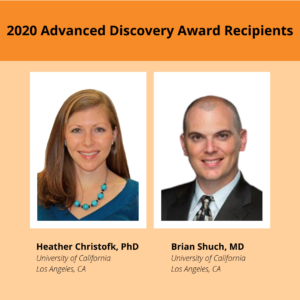
The Legacy
April 11, 2024
This is a guest post by Christopher Wood, Jr, son of the KCA’s late Board Chair and friend, Dr. Christopher…
Read More
Dr. Heather Christofk and Dr. Brian Shuch of the University of California, Los Angeles received a 2020 Advanced Discovery Award for their investigation of “Intracellular asparagine regulates mTORC1 activity and cancer cell proliferation”, which takes a closer look at how the amino acid asparagine might be important in kidney cancer growth.
Dr. Christofk is a Professor of Biological Chemistry, and Dr. Shuch is a urologist and directs UCLA’s Kidney Cancer Program. We spoke with them about their work and its potential impact on patients.
Dr. Heather Christofk (HC): For a long time, my lab has been interested in what nutrients are limiting for cancer growth. A few years ago, we discovered that asparagine is a special nutrient that’s critical in tumor growth. In order to make asparagine, cells need a functional citric acid cycle [TCA cycle], which facilitates respiration and energy generation and helps build certain molecules, including asparagine.
Kidney tumors have reduced TCA cycle function, which is bizarre because it’s a really important pathway, and even have genetic mutations that disable it. After Brian moved to UCLA, he and I were chatting about some rare aggressive forms of kidney cancer that have mutations in the TCA cycle. At that point, it clicked that this is the type of cancer where we should apply our knowledge about the importance of asparagine for cancer growth and try to limit the tumor cells’ ability to take it up. There is already an FDA-approved drug used in acute lymphoblastic leukemia that disables tumor cells’ ability to take up asparagine. It made perfect sense for us to look in Brian’s patients who had these aggressive forms of RCC that had mutations in the TCA cycle enzymes to see if they are sensitive to this drug, L-asparaginase.
Dr. Brian Shuch (BS): Kidney cancer also has a sweet tooth – it relies on sugar and processes like glycolysis to generate energy rather than using the TCA cycle efficiently.
HC: We think the dependence on getting asparagine from outside the cell because of the depressed TCA cycle, is a vulnerability of kidney cancer that can be exploited therapeutically. We are also using metformin, which is widely used in clinic [for diabetes], because it will prevent tumor cells from finding a way around L-asparaginase treatment. I’ve found this combination [of metformin plus L-asparaginase] very effective in limiting cancer growth in mouse models. Applying this to kidney cancer is something we’re very excited about, in large part due to Brian’s enthusiasm and deep knowledge of this cancer type.
BS: This may be a really exciting strategy across multiple forms of kidney cancer, not just unusual genetic forms. This approach would basically be a pan-kidney approach in finding therapeutic options. If we are able to test models in some of these more severe genetic forms of clear cell, papillary, and chromophobe kidney cancer, opportunities across other kidney cancer types may become available.
BS: The fact that we have preexisting drugs that have already been tested and are widely available – over 40 million Americans are on metformin for diabetes; asparaginase is proven and safe – they can be brought to the clinic [for kidney cancer] in the next year or two after trials.
HC: Hopefully we have designed our experiments so that our animal models will mimic the patient population that we are interested in treating and these trials can advise clinical trials in the near future so we can get answers about what works for patients, especially patients that don’t have other treatment options.
HC: There is a target here based on our basic research – the enzyme that makes asparagine – and there are FDA-approved drugs for it that are known to be safe. That is the route I prefer, because my goal is to help patients and for our research to have an impact as soon as possible. Some of the patients that Brian sees now cannot wait for a new drug and all the processes that need to happen for that drug to make it to the clinic. For this project, I am really excited about how quickly we can move this into the clinic. That is one of the reasons I am excited to work on this project with Brian because he can also design and lead a clinical study on it soon.
BS: I would say that it is exciting to develop new drugs for new targets, but we could be talking about something 5-10 years away. And you have to find the right industry partner. These [existing drugs] are well tolerated, they are there to be used, and we will have them available to patients right away.
HC: I have had several clinical collaborators since I started my lab over a decade ago, but I have to say that Brian is the best clinical collaborator that I have ever had. Since he moved to UCLA, we have other ongoing projects together, but this is our main project with the shared goal to translate our discoveries to his patients. Our collaboration goes both ways. Not only are discoveries from my lab going to his patients, but also there are mutations he sees in his patients, which we can test in the lab.
BS: I second that, I moved here to work with the best and the brightest, and gone are the days when you could have a one man or woman show where you can basically do everything yourself. We do not want to go bench to bedside, we want to be bedside to bench and back to bedside where we can take unique clinical observations, get patient samples, test strategies, and transition back again. I consider myself a clinician-scientist, but the type of work I do would take years to make something of it, so if I can identify a brilliant scientist like Heather and get her motivated on the disease and patients, we can accelerate discoveries much quicker. Rising tides lifts all boats is what they say and I have a good captain of the ship to partner with.
BS: In the past few years there has been an influx of kidney cancer funding through opportunities like the Kidney Cancer Association and the Department of Defense. We are very thrilled and would like to thank Gretchen [Vaughan, KCA’s President and CEO] and Dr. Wood [Dr. Christopher Wood of MD Anderson Cancer Center and Chair of the KCA’s Board of Directors] and the rest of the KCA team that we will be able to bring this project forward.
HC: We are so excited to have the funding to do this project, test our hypothesis, and see whether it makes sense to translate this discovery to the clinic to help Brian’s patients.
BS: I would say I am pretty confident that in the next 12 to 18 months that we will have some data to bring forward for a small trial to test this strategy. We hope this works and that it is the next target for kidney cancer. A lot of ideas just die in the lab. I think this one has a real path forward right to the clinic, with the support of the KCA.